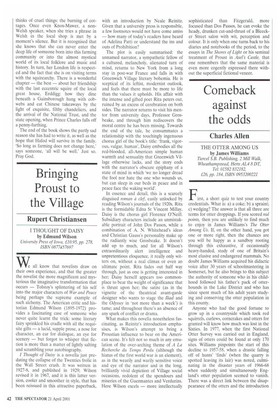Comeback against the odds
Charles Allen
THE 0 1 1ER AMONG US by James Williams Tierce' S.B. Publishing, 2 Mill Wallc, Wheathampstead, Herts AL4 8 DT, Tel: 01582 832182, £26, pp. 184, ISBN 0953200221 First, a short quiz to test your country credentials. What is: a) a coke; b) a spraint; c) wedging? The answer is that all three are terms for otter droppings. If you scored nul points, then you are unlikely to find much to enjoy in James Williams's The Otter Among Us. If, on the other hand, you got one or more right, then the chances are you will be happy as a sandboy rooting through this exhaustive, if occasionally heavy-handed, study of one of Britain's most elusive and endangered mammals. No doubt James Williams acquired his didactic voice after 30 years of schoolmastering in Somerset, but he also brings to this subject the authority of someone who in his childhood followed his father's pack of otterhounds in the Lake District and who has since spent much of his adult years studying and conserving the otter population in this county.
Anyone who had the good fortune to grow up in a countryside which took red squirrels, curlews, corncrakes and otters for granted will know how much was lost in the Sixties. In 1977, when the first National Otter Survey was carried out in England, signs of otters could be found at only 170 sites. Williams pinpoints the start of this decline to 1957-58, when a drastic falling off of hunts' finds' (when the quarry is spotted leaving its lair) was noted, culminating in the disaster years of 1966-68 when suddenly and simultaneously England's otter population seemed to vanish. There was a direct link between the disappearance of the otters and the introduction of a new range of organochlorine chemicals to replace DDT. They eliminated sheep scab and rust and fungi in wheat but they passed as highly toxic pollutants into the rivers and then by way of the eel into the otter's food chain. In 1972 Williams sent a bitch otter found dead beside the river Tone for scientific analysis at a government laboratory. Sixteen months later he received a reply informing him that the otter contained 14 parts per million of dieldrin in its liver, a world record, 1 ppm being enough to kill a fox. Dieldrin was supposed to have been banned as a seeddressing ten years earlier and as a sheepdip six years earlier.
Here in Somerset continuing pollution of the rivers from slurry and sterilisers used to clean milking machinery on livestock farms, combined with land-drainage schemes, hedge clearances, orchard grubbing, the sowing of winter wheat and other characteristics of agri-business, have all helped to further foul the otter's habitat and restrict its breeding. In 1980, in the wake of reports of an otter comeback on the Somerset Levels, Williams carried out an extensive survey for the Somerset Wildlife Trust. He found just two single spraints, on adjacent bridges on the same day: 'There had been one otter only, on one day, and it did not return.' At that time the combined otter population for this county and that part of Devon which shares the 'Tarka the Otter Trail' with Somerset was probably less than ten.
Fortunately, it has since become apparent that the extinction of this most graceful of fishers has been averted and the decline reversed, In 1994, the year of the third national survey, signs of otter activity were found at 706 sites. Since then the Somerset Otter Group's annual two-day search has produced figures that are hugely encouraging, rising year by year from 15 in 1995 to 35 in 200. Should this rise continue we may expect 75 per cent occupancy of our Somerset rivers by the year 2002, and 50 per cent occupancy for the rest of England. Williams urges caution, but the return of the otter against all the odds must surely give us cause for hope. Much of this reversal has been achieved by the efforts of conservancy bodies working at local level, urging good practices that can be as simple as putting a fence alongside a stream to stop cattle trampling down the banks. And to their credit, many farmers have played their part.
A tiny victory, perhaps, when set against the background of these last months of horror piled upon horror across the countryside, but perhaps an augury of better days to come. 'In my adult lifetime,' concludes Williams, 'we nearly let the wonderful animal that I dream about all day and think about much of the night slip away into extinction .... That the otter is still among us restores to us a proper understanding of our rightful place in the scheme of things.'



































































 Previous page
Previous page